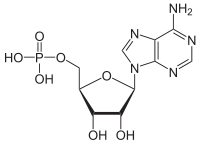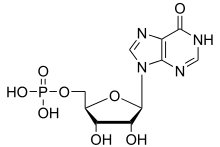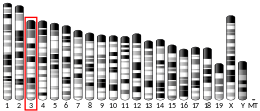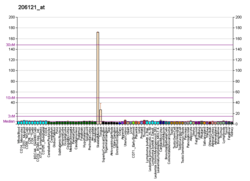AMP deaminase
AMP deaminase 1 is an enzyme that in humans is encoded by the AMPD1 gene.[5][6]
Adenosine monophosphate deaminase is an enzyme that converts adenosine monophosphate (AMP) to inosine monophosphate (IMP), freeing an ammonia molecule in the process.
Function
Adenosine monophosphate deaminase 1 catalyzes the deamination of AMP to IMP in skeletal muscle and plays an important role in the purine nucleotide cycle. Two other genes have been identified, AMPD2 and AMPD3, for the liver- and erythrocyte-specific isoforms, respectively. Deficiency of the muscle-specific enzyme is apparently a common cause of exercise-induced myopathy and probably the most common cause of metabolic myopathy in the human.[6]
A research report shows that the widely prescribed diabetes medication metformin works on AMP-activated kinase (AMPK) by directly inhibiting AMP deaminase, thereby increasing cellular AMP.[7]
Regulation
It has been shown that in environments with high potassium concentrations, AMP-deaminase is regulated by ATP and ADP through a “Km-type” mechanism. In low potassium ion concentrations, a mixed “Km V-type” of the regulation is observed.[8]
Pathology
A deficiency is associated with myoadenylate deaminase deficiency.
 adenosine monophosphate (AMP)
adenosine monophosphate (AMP) inosine monophosphate (IMP)
inosine monophosphate (IMP)
References
- GRCh38: Ensembl release 89: ENSG00000116748 - Ensembl, May 2017
- GRCm38: Ensembl release 89: ENSMUSG00000070385 - Ensembl, May 2017
- "Human PubMed Reference:". National Center for Biotechnology Information, U.S. National Library of Medicine.
- "Mouse PubMed Reference:". National Center for Biotechnology Information, U.S. National Library of Medicine.
- Mahnke-Zizelman DK, Sabina RL (October 1992). "Cloning of human AMP deaminase isoform E cDNAs. Evidence for a third AMPD gene exhibiting alternatively spliced 5'-exons". J. Biol. Chem. 267 (29): 20866–77. PMID 1400401.
- EntrezGene 270
- Ouyang J, Parakhia RA, Ochs RS (January 2011). "Metformin activates AMP kinase through inhibition of AMP deaminase". J. Biol. Chem. 286 (1): 1–11. doi:10.1074/jbc.M110.121806. PMC 3012963. PMID 21059655.
- Skladanowski, Andrzej (1979). "Potassium-dependent regulation by ATP and ADP of AMP-deaminase from beef heart". International Journal of Biochemistry. 10 (2): 177–181. doi:10.1016/0020-711X(79)90114-9. PMID 428625.
Further reading
- Fishbein WN, Armbrustmacher VW, Griffin JL (1978). "Myoadenylate deaminase deficiency: a new disease of muscle". Science. 200 (4341): 545–8. doi:10.1126/science.644316. PMID 644316.
- Sabina RL, Fishbein WN, Pezeshkpour G, et al. (1992). "Molecular analysis of the myoadenylate deaminase deficiencies". Neurology. 42 (1): 170–9. doi:10.1212/wnl.42.1.170. PMID 1370861.
- Morisaki T, Gross M, Morisaki H, et al. (1992). "Molecular basis of AMP deaminase deficiency in skeletal muscle". Proc. Natl. Acad. Sci. U.S.A. 89 (14): 6457–61. doi:10.1073/pnas.89.14.6457. PMC 49520. PMID 1631143.
- Sabina RL, Morisaki T, Clarke P, et al. (1990). "Characterization of the human and rat myoadenylate deaminase genes". J. Biol. Chem. 265 (16): 9423–33. PMID 2345176.
- Dale GL (1989). "Radioisotopic assay for erythrocyte adenosine 5'-monophosphate deaminase". Clin. Chim. Acta. 182 (1): 1–7. doi:10.1016/0009-8981(89)90144-7. PMID 2502331.
- Mercelis R, Martin JJ, Dehaene I, et al. (1981). "Myoadenylate deaminase deficiency in a patient with facial and limb girdle myopathy". J. Neurol. 225 (3): 157–66. doi:10.1007/BF00313744. PMID 6167680.
- van Laarhoven JP, de Gast GC, Spierenburg GT, de Bruyn CH (1983). "Enzymological studies in chronic lymphocytic leukemia". Leuk. Res. 7 (2): 261–7. doi:10.1016/0145-2126(83)90016-4. PMID 6406772.
- Kelemen J, Rice DR, Bradley WG, et al. (1982). "Familial myoadenylate deaminase deficiency and exertional myalgia". Neurology. 32 (8): 857–63. doi:10.1212/wnl.32.8.857. PMID 7201581.
- Baumeister FA, Gross M, Wagner DR, et al. (1993). "Myoadenylate deaminase deficiency with severe rhabdomyolysis". Eur. J. Pediatr. 152 (6): 513–5. doi:10.1007/BF01955062. PMID 8335021.
- Morisaki T, Holmes EW (1993). "Functionally distinct elements are required for expression of the AMPD1 gene in myocytes". Mol. Cell. Biol. 13 (9): 5854–60. doi:10.1128/MCB.13.9.5854. PMC 360332. PMID 8355716.
- Bruno C, Minetti C, Shanske S, et al. (1998). "Combined defects of muscle phosphofructokinase and AMP deaminase in a child with myoglobinuria". Neurology. 50 (1): 296–8. doi:10.1212/wnl.50.1.296. PMID 9443500.
- Hisatome I, Morisaki T, Kamma H, et al. (1998). "Control of AMP deaminase 1 binding to myosin heavy chain". Am. J. Physiol. 275 (3 Pt 1): C870–81. doi:10.1152/ajpcell.1998.275.3.C870. PMID 9730972.
- Sims B, Powers RE, Sabina RL, Theibert AB (1999). "Elevated adenosine monophosphate deaminase activity in Alzheimer's disease brain". Neurobiol. Aging. 19 (5): 385–91. doi:10.1016/S0197-4580(98)00083-9. PMID 9880040.
- Loh E, Rebbeck TR, Mahoney PD, et al. (1999). "Common variant in AMPD1 gene predicts improved clinical outcome in patients with heart failure". Circulation. 99 (11): 1422–5. doi:10.1161/01.cir.99.11.1422. PMID 10086964.
- Abe M, Higuchi I, Morisaki H, et al. (2000). "Myoadenylate deaminase deficiency with progressive muscle weakness and atrophy caused by new missense mutations in AMPD1 gene: case report in a Japanese patient". Neuromuscul. Disord. 10 (7): 472–7. doi:10.1016/S0960-8966(00)00127-9. PMID 10996775.
- Morisaki H, Higuchi I, Abe M, et al. (2001). "First missense mutations (R388W and R425H) of AMPD1 accompanied with myopathy found in a Japanese patient". Hum. Mutat. 16 (6): 467–72. doi:10.1002/1098-1004(200012)16:6<467::AID-HUMU3>3.0.CO;2-V. PMID 11102975.
- Gross M, Rötzer E, Kölle P, et al. (2002). "A G468-T AMPD1 mutant allele contributes to the high incidence of myoadenylate deaminase deficiency in the Caucasian population". Neuromuscul. Disord. 12 (6): 558–65. doi:10.1016/S0960-8966(02)00008-1. PMID 12117480.
- Mahnke-Zizelman DK, Sabina RL (2003). "N-terminal sequence and distal histidine residues are responsible for pH-regulated cytoplasmic membrane binding of human AMP deaminase isoform E." J. Biol. Chem. 277 (45): 42654–62. doi:10.1074/jbc.M203473200. PMID 12213808.
External links
- AMP+Deaminase at the US National Library of Medicine Medical Subject Headings (MeSH)
- Human AMPD1 genome location and AMPD1 gene details page in the UCSC Genome Browser.




